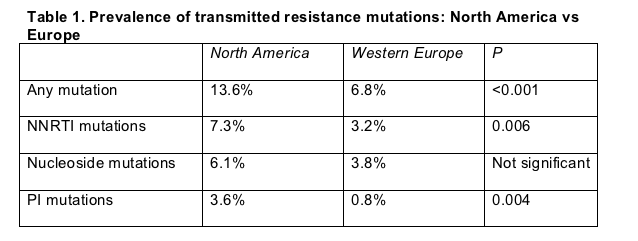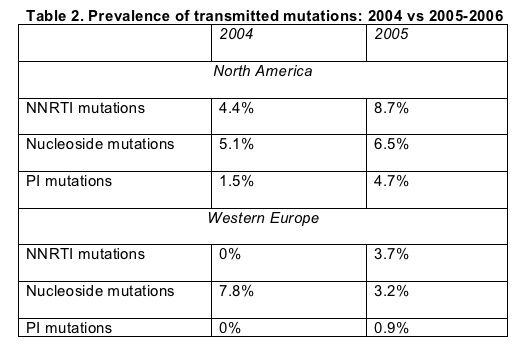 |
 |
 |
| |
Transmitted Resistance Worse in North American Than in Europe
|
| |
| |
XVI International HIV Drug Resistance Workshop
June 12-16, 2007
Barbados
Mark Mascolini
People in the US and Canada get infected with resistant virus more often than Western Europeans, according to analysis of more than 900 antiretroviral-naive people enrolling in two clinical trials from 2004 through 2006 [1]. On both continents rates of nonnucleoside (NNRTI) mutations easily outpaced rates of protease inhibitor (PI) mutations. This analysis by Abbott investigators also graphed a nonsignificant trend toward increasing transmission of resistant virus in North America and Western Europe from 2004 to 2005-2006.
The study has two distinct limits: People enrolling in clinical trials may not accurately represent the broader population of HIV-infected people from which they come. And as the Abbott researchers observed, they used standard genotyping assays to search for resistance mutations, but more sensitive noncommercial tests routinely find higher mutation rates in untreated Europeans and North Americans [2-4].
Abbott looked for pretreatment mutations in 413 North Americans (including 88 Canadians), 500 Western Europeans, and 70 people from other countries. Because few people from each of these other countries enrolled in the trials, the investigators cautioned against reading too much into resistance trends there, and this report omits those findings.
Among people with available demographic data, 78% were male, 72% white, and 22% black. For 817 people with a recorded time of HIV diagnosis, median time since diagnosis and trial screening measured 10.4 months. In that time populations of some mutations probably did dwindle to levels undetectable by standard genotyping. The study used a list of 80 mutations at 39 sites in protease and reverse transcriptase developed by non-Abbott researchers for global surveillance of transmitted resistance [5].
Prevalence of any resistance mutation and of NNRTI and PI mutations proved significantly higher in North America than in Western Europe (Table 1). Within each region NNRTI mutations appeared significantly more often than PI mutations (P = 0.031 for North America, P = 0.011 for Europe).

Overall prevalence of mutations conferring resistance to each antiretroviral group across all regions (including the "other" countries) was 5.1% for NNRTIs, 4.8% for nucleosides, and 1.9% for PIs. Only 1% to 2% of trial enrollees in each region had virus resistant to drugs in two or more antiretroviral classes.
The most prevalent individual mutations were the NNRTI changes K103N/S (5.3% in North America versus 1.6% in Western Europe) and Y181C/I (1.7% in North America and 0.6% in Western Europe) and the thymidine nucleoside analog mutations at position 215 (3.6% in North America versus 2.2% in Western Europe), M41L (2.2% in North America versus 1.4% in Western Europe), and K219Q/E (1.5% in Western Europe versus 0.8% in Western Europe).

Rates of mutations to the three antiretroviral classes rose nonsignificantly--but steeply enough for NNRTI and PI mutations--in both North America and Western Europe (Table 2). Fewer Western Europeans in the 2005-2006 trial than in the 2004 trial got infected with nucleoside-resistant virus.
References
1. Rahim S, Fredrick LM, da Silva B, et al. Geographical and temporal trends of transmitted HIV-1 drug resistance among antiretroviral-naive subjects screening for clinical trials. Antiviral Therapy. 2007;12:S56. Abstract 49.
2. Simen BB, Huppler Hullsiek K, Novak RM, et al. Prevalence of low abundant drug-resistant variants by ultra-deep sequencing in chronically HIV-infected antiretroviral (ARV)-naive patients and the impact on virological outcomes. Antiviral Therapy. 2007;12:S149. Abstract 134.
3. Johnson JA, Lipscomb J, J-F Li, et al. Real-time PCR testing allows for sensitive drug
resistance screening and mutation linking in HIV-1. Antiviral Therapy. 2007;12:S153. Abstract 39.
4. Metzner KJ, Rauch P, von Wyl V, et al. Prevalence of minority quasispecies of drug-resistant HIV-1 in patients with primary HIV-1 infection in Zurich in the years 2002-2006. Antiviral Therapy. 2007;12:S47. Abstract 40.
5. Shafer RW, Rhee SY, Pillay D, et al. HIV-1 protease and reverse transcriptase mutations for drug resistance surveillance. AIDS. 2007;21:215-223.
|
| |
|
 |
 |
|
|